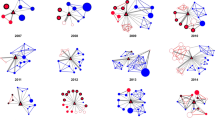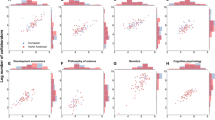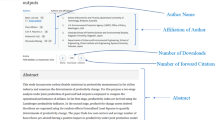Abstract
Science has become more collaborative over the past years, as evidenced by the growing number of authors per publication and the emergence of interdisciplinary research endeavors involving specialists from different fields. In this context, it is not trivial to quantify the individual impact of researchers. To address this issue, we evaluate the effect of the most productive collaboration tie (as measured by the number of co-authored papers) on the productivity and visibility metrics of established researchers. We analyzed the impact on the researcher’s metrics, such as the number of publications, citations, and h-index, when their co-authored works with their most productive collaborator were excluded from the analysis. A comprehensive analysis conducted utilizing over 243 million papers revealed different patterns of prolific collaborator influence across the major fields of knowledge. In formal and applied sciences, the impact of prolific collaborators on the visibility metrics of authors is substantial, even among those who are highly cited. These results have significant implications for stakeholders who are seeking to understand collaboration patterns and to develop measures of success that consider collaboration ties.









Similar content being viewed by others
References
Abramo, G., & D’Angelo, C. A. (2014). How do you define and measure research productivity? Scientometrics, 101(2), 1129–1144.
Abramo, G., & Angelo, A. (2015). The relationship between the number of authors of a publication, its citations and the impact factor of the publishing journal: Evidence from Italy. Journal of Informetrics, 9(4), 746–761.
Abramo, G., D’Angelo, C. A., & Di Costa, F. (2009). Research collaboration and productivity: Is there correlation? Higher Education, 57(2), 155–171.
Abramo, G., Cicero, T., & D’Angelo, C. A. (2013). Individual research performance: A proposal for comparing apples to oranges. Journal of Informetrics, 7(2), 528–539.
Ajiferuke, I., & Wolfram, D. (2010). Citer analysis as a measure of research impact: Library and information science as a case study. Scientometrics, 83(3), 623–638.
Ajiferuke, I., Lu, K., & Wolfram, D. (2010). A comparison of citer and citation-based measure outcomes for multiple disciplines. Journal of the American Society for Information Science and Technology, 61(10), 2086–2096.
Amancio, R., Oliveira, N., Jr., Costa, F., et al. (2012). On the use of topological features and hierarchical characterization for disambiguating names in collaborative networks. EPL, 99(4), 48002.
Amancio, D. R., Oliveira, O. N., Jr., & Costa, Ld. F. (2015). Topological-collaborative approach for disambiguating authors‘ names in collaborative networks. Scientometrics, 102(1), 465–485.
Batista, P. D., Campiteli, M. G., & Kinouchi, O. (2006). Is it possible to compare researchers with different scientific interests? Scientometrics, 68(1), 179–189.
Beaver, D. (2001). Reflections on scientific collaboration (and its study): Past, present, and future. Scientometrics, 52(3), 365–377.
Brito, C., Silva, N., Amancio, R., et al. (2021). Associations between author-level metrics in subsequent time periods. Journal of Informetrics, 15(4), 101–218.
Bukvova, H. (2010). Studying research collaboration: A literature review. All Sprouts Content, 10(3), 326.
Chacon, X. S., Silva, T. C., & Amancio, D. R. (2020). Comparing the impact of subfields in scientific journals. Scientometrics, 125, 625–639.
Corrêa, E. A., Jr., Silva, F. N., Costa, Ld. F., & Amancio, D. R. (2017). Patterns of authors contribution in scientific manuscripts. Journal of Informetrics, 11(2), 498–510.
Fenner, M. (2014). Altmetrics and other novel measures for scientific impact. Opening science (pp. 179–189). Springer.
Freeman, R. B., Ganguli, I., & Murciano-Goroff, R. (2015). Why and Wherefore of Increased Scientific Collaboration. University of Chicago Press.
García-Pérez, M. A. (2012). An extension of the h index that covers the tail and the top of the citation curve and allows ranking researchers with similar h. Journal of Informetrics, 6(4), 689–699.
Harzing, A. W. (2016). Microsoft academic (search): A phoenix arisen from the ashes? Scientometrics, 108(3), 1637–1647.
Hug, S. E., & Brändle, M. P. (2017). The coverage of microsoft academic: Analyzing the publication output of a university. Scientometrics, 113, 1551–1571.
Ioannidis, P., Klavans, R., Boyack, W., et al. (2016). Multiple citation indicators and their composite across scientific disciplines. PLoS Biology, 14(7), e1002501.
Ioannidis, P., Boyack, W., Baas, J., et al. (2020). Updated science-wide author databases of standardized citation indicators. PLoS Biology, 18(10), e3000918.
Larivière, V., Gingras, Y., Sugimoto, C. R., & Tsou, A. (2015). Team size matters: Collaboration and scientific impact since 1900. Journal of the Association for Information Science and Technology, 66(7), 1323–1332.
Li, W., Aste, T., Caccioli, F., & Livan, G. (2019). Reciprocity and impact in academic careers. EPJ Data Science, 8(1), 20.
Mabry, P. L., Yan, X., Pentchev, V., Van Rennes, R., McGavin, S. H., & Wittenberg, J. V. (2020). Cadre: A collaborative, cloud-based solution for big bibliographic data research in academic libraries. Frontiers in Big Data, 3, 42.
Pelacho, M., Ruiz, G., Sanz, F., Tarancón, A., & Clemente-Gallardo, J. (2021). Analysis of the evolution and collaboration networks of citizen science scientific publications. Scientometrics, 126(1), 225–257.
Qin, J., Lancaster, F. W., & Allen, B. (1997). Types and levels of collaboration in interdisciplinary research in the sciences. Journal of the American Society for Information Science, 48(10), 893–916.
Sabharwal, M. (2013). Comparing research productivity across disciplines and career stages. Journal of Comparative Policy Analysis: Research and Practice, 15(2), 141–163.
Silva, F. N., Amancio, D. R., Bardosova, M., Costa, Ld. F., & Oliveira, O. N., Jr. (2016). Using network science and text analytics to produce surveys in a scientific topic. Journal of Informetrics, 10(2), 487–502.
Thelwall, M. (2017). Microsoft academic: A multidisciplinary comparison of citation counts with Scopus and Mendeley for 29 journals. Journal of Informetrics, 11(4), 1201–1212.
Tohalino, J. A. V., & Amancio, D. R. (2018). Extractive multi-document summarization using multilayer networks. Physica A: Statistical Mechanics and its Applications, 503, 526–539.
Tohalino, V., Silva, C., Amancio, R., et al., (2023) Using citation networks to evaluate the impact of text length on the identification of relevant concepts. arXiv preprint arXiv:2301.06168
Viana, M. P., Amancio, D. R., & Costa, Ld. F. (2013). On time-varying collaboration networks. Journal of Informetrics, 7(2), 371–378.
Wang, K., Shen, Z., Huang, C., Wu, C. H., Eide, D., Dong, Y., Qian, J., Kanakia, A., Chen, A., & Rogahn, R. (2019). A review of microsoft academic services for science of science studies. Frontiers in Big Data, 2, 45.
Wang, K., Shen, Z., Huang, C., Wu, C. H., Dong, Y., & Kanakia, A. (2020). Microsoft academic graph: When experts are not enough. Quantitative Science Studies, 1(1), 396–413.
Acknowledgements
A preprint version of this manuscript is available at arXiv. A.C.M.B. acknowledges financial support from São Paulo Research Foundation (FAPESP Grant No. 2020/14817-2) and Capes-Brazil for sponsorship. D.R.A. acknowledges financial support from FAPESP (Grant No. 20/06271-0) and CNPq-Brazil (Grant Nos. 304026/2018-2 and 311074/2021-9). This material is partially supported by AFOSR #FA9550-19-1-0391.
Author information
Authors and Affiliations
Corresponding author
Ethics declarations
Conflict of interest
The authors have no conflicts of interest to declare.
Electronic Supplementary Information
Below is the link to the electronic supplementary material.
Rights and permissions
Springer Nature or its licensor (e.g. a society or other partner) holds exclusive rights to this article under a publishing agreement with the author(s) or other rightsholder(s); author self-archiving of the accepted manuscript version of this article is solely governed by the terms of such publishing agreement and applicable law.
About this article
Cite this article
Brito, A.C.M., Silva, F.N. & Amancio, D.R. Analyzing the influence of prolific collaborations on authors productivity and visibility. Scientometrics 128, 2471–2487 (2023). https://doi.org/10.1007/s11192-023-04669-7
Received:
Accepted:
Published:
Issue Date:
DOI: https://doi.org/10.1007/s11192-023-04669-7




